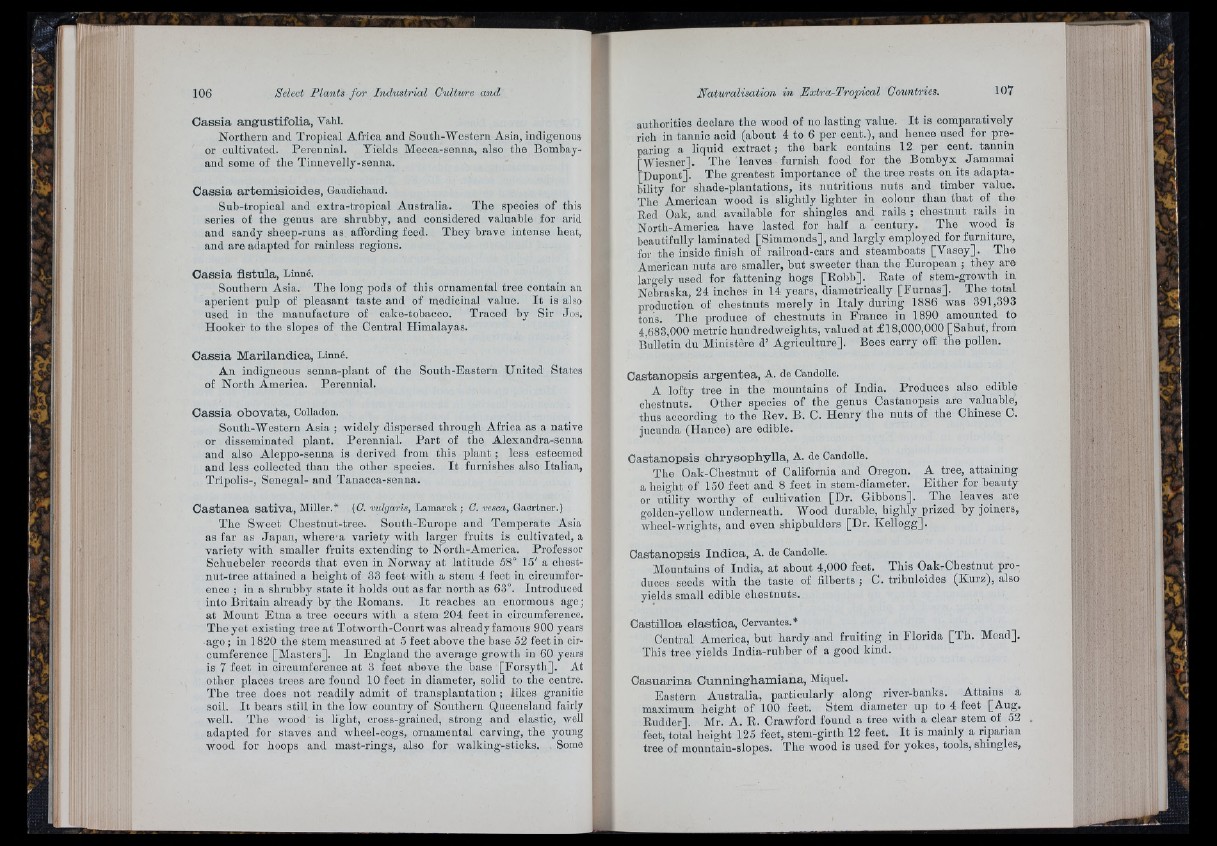
C a s s i a a n g u s t if o l i a , Vahl.
Northern aiul Tropical Africa and South-Wcstorn Asia, indigenous
or cultivated. Perennial. Yields Meoca-seiina, also the Bombay-
and some of the Tinucvelly-soima.
C a s s i a a r tem i s io id e s , Gaudichaud.
Sub-tropical and extra-tropical Australia. The species of this
series of the genus are shrubby, and considered valuable for arid
and sandy sheep-runs as affording feed. They brave intense heat,
and are adapted for rainless regions.
C a s s i a f i s tu la , Linné.
Soutliern Asia. The long pods of this ornamental tree contain an
aperient pulp of pleasant taste and of medicinai value. I t is also
used in the manufacture of cake-tobacco. Traced by Sir Jos.
Hooker to tlie slopes of the Central Himalayas.
C a s s i a M a r ila n d ic a , Linné.
An indigneons senna-plant of the South-Eastern United States
of North America. Perennial.
C a s s ia o b o v a ta , Colladon.
South-Western Asia ; widely dispersed through Africa as a native
or disseminated plant. Perennial. P a rt of the Alexandra-seuna
and also Aloppo-seima is derived from this plant ; less esteemed
and less collected than tlie other species. I t furnishes also Italian,
Tripolis-, Senegal- and Tauacca-senna.
C a s t a n e a s a t iv a , Miller.* (G. vulgaris, Lamarck; G. vesca, Gaertner.)
The Sweet Chestnut-tree. South-Europe and Temperate Asia
as far as Japan, where a variety with larger fruits is cultivated, a
variety with smaller fruits extending to Nortli-America. Professor
Schuebeler records th a t even in Norway at latitude 58° 15' a chest-
nut-troe attained a height of 33 feet witli a stem 4 feet in circumference
; in a shrubby state it holds out as far nortli as 63°. Introduced
into Britain already by the Eomans. I t reaches an enormous age;
at Mount Etn a a tree occurs witli a stem 204 feet in circumference.
The yet existing tree a t Totworth-Court was already famous 900 years
ago ; in 1820 the Stem measured at 5 feet above tlie base 52 feet in circumference
[Masters]. In England the average growtli in 60 years
is 7 feet in circumference at 3 feet above the base [Forsyth]. At
other places trees are found 10 feet in diameter, solid to tlio centre.
The tree does not readily admit of transplantation ; likes granitic
soil. I t hears still in the low country of Southern Queensland fairly
well. 'The wood is light, cross-grained, strong and elastic, well
adapted for staves aud whcel-cogs, ornamental carving, the young
wood for hoops aud mast-rings, also for walking-sticks. Some
authorities declare the wood of no lasting value. I t is comparatively
rich in tannic acid (about 4 to 6 per cent.), and lience used for pre-
laring a liquid extract ; the bark contains 12 per cent, tannin
'Wiesner]. The leaves furnish food for the Bombyx Jamamai
‘Dupont]. Tiie greatest importance of the tree rests on its adapta-
iility for shade-plantations, its nutritious nuts and timber value.
The American wood is slightly lighter in colour than th a t of the
Bed Oak, and available for shingles and rails ; chestnut rails in
North-America have lasted for half a century. The wood is
beautifully laminated [Simmonds], and largly employed for furniture,
for the inside finish of railroad-cars and steamboats [Vasoy]. Tlie
American nuts are smaller, but sweeter than tlie European ; they are
largely used for fattening hogs [Kohl)]. Rate of stem-growth in
Nebraska, 24 inches in 14 years, diametrically [F u rn a s]. The total
production of chestnuts merely in Italy during 1886 was 391,393
tons. 'The produce of chestnuts in France in 1890 amounted to
4,683,000 metric hundredweights, valued a t £18,000,000 [Sahut, from
Bulletin du Ministère d’ Agriculture]. Bees carry off the pollen.
C a s ta n o p s is a r g e n t e a , A. de Candolle.
A lofty tree in the mountains of India. Produces also edible
chestnuts. Otlier species of the genus Castanopsis are valuable,
thus according to the Rev. B. C. Henry the nuts of the Chinese C.
jiiciinda (Hance) are edible.
C a s ta n o p s is c h r y s o p h y l la , A. de Candolle.
The Oak-Chestnut of California aud Oregon. A tree, attaining
a height of 150 feet and 8 feet in stem-diameter. Either for beauty
or utility worthy of cultivation [Dr. Gibbons]. 'The leaves are
golden-yellow underneath. Wood durable, highly prized by joiners,
wheel-wrights, aud even shipbulders [Dr. Kellogg].
C a s ta n o p s is I n d i c a , A. de Candolle.
Mountains of India, at about 4,000 feet. This Oak-Chestnut produces
seeds with the taste of filberts ; C. tribuloidos (Kurz), also
yields small edible chestnuts.
C a s tillo a e la s t i c a , Cervantes.*
Central America, but hardy and fruiting in Florida [T h . Moad].
This tree yields India-rubber of a good kind.
C a s u a r in a C u n n in g h am i a n a , Miqnel.
Eastern Australia, particularly along river-banks. Attains a
maximum height of 100 feet. Stem diameter up to 4 feet [Aug.
Rudder]. Mr. A. B. Crawford found a tree with a clear stem of 52
feet, total lieight 125 feet, stem-girth 12 feet. I t is mainly a rip.arian
tree of mountaiu-slopes. 'The wood is used for yokes, tools, shingles.
i ; r C'
il'
m -
, ■ ■tii